XENOTACTICS RULES
2nd Edition
v2.4
© 2018 Leo Salomaa
.00
INTRODUCTION
Xenotactics is a tactical sci-fi skirmish game where rival warbands face off on worlds far far away.
The gameplay is centered around meaningful player decisions. Among other things, you'll be making tough choices activating your warband, reacting to enemies during their turn and deciding when to play it safe and when to take risks.
Simplicity is sophistication. Xenotactics has no modifiers to calculate, tables to look up or counters to clutter the battlefield. A mission lasts under an hour so you can finish a short campaign in an evening. Or play best out of three if you have a competitive craving. As warbands only number a few miniatures they're quick to paint and prepare for battle.
Xenotactics is also about creativity. There is no official background story but you can certainly use it for existing settings or make up your own. Likewise the game is not associated with any specific line of models, instead you use whatever models you like best or happen to own. For this purpose the game features a system for creating characters from scratch. By design, Xenotactics plays well with miniatures from any manufacturer.
The game is improved continuously as well. Shoot a mail to salomaa.leo at gmail.com if you have an idea on how to improve the game or want to take part in the development.
WHAT YOU'LL NEED
- 3-20 Miniatures per player
- Someone to play against
- A flat playing surface, like a kitchen table
- 3 ten sided dice per player
- Tape measure
- Miniature terrain. Cut shapes from paper for a quick solution
- You’ll also need
- Imagination
- Sportsmanship
- Mad tactical skills
.01
CORE RULES
MINIATURES
Xenotactics is aimed at 28-32mm miniatures. All miniatures need to be fixed on bases but the shape of the base is up to you. Miniatures are called models in the rules.

BASE CONTACT
When two models' bases are touching they are said to be in base contact, which is short for base to base contact.
MEASURING
You're allowed to measure distances at any time. Distances between models are measured from their bases. If models are on different height levels you can instead measure distances between imaginary 2” high volumes extending upwards from their bases. These block line of sight.
LINE OF SIGHT
A model has line of sight to another model when you can draw a straight unobstructed line between the models' bases or the the imaginary volumes described above.
STARTING, PLAYING AND ENDING THE GAME
Before the game starts players design their warband. This is the group of models they will use during the game.
At the start of the game, players deploy terrain and warbands on the gaming table. After this the game starts. Players activate their warbands in turns as models are moved around the battlefield and dice are rolled. The battle rages on and legends are made.
As the dust settles one warband stands victorious. The other warband has been taken out or the turn limit has been reached.
STATS
High stats are better than low ones.
- Move: 3 to 9, Movement distance in inches and probability to dodge.
- Attack: 3 to 9, Probability to hit when attacking.
- Defence: 1 to 7, Probability to avoid loosing hit points or getting stunned when taking damage.
- Quality: 3 to 9, Probability to retain your turn after activating the model.
- Hit Points: 1 to 7, The model dies when it looses its last hit point. Most warriors have one hit point while heroes, monsters or big robots have more.
Weapon stats:
- Firepower: 1d10 to 3d10. The number of attack dice per attack action.
- Damage: 1 to 3. The amount of damage caused by each successful attack roll.
DICE AND ROLLS
Xenotactics uses 10 sided dice which will be called d10 in the rules from now on. A roll below or equal to a stat is successful while a roll over a stat is a failure. 3d10 means you would roll three of these dice and compare each result against the stat separately.
Some rules allow you to re-roll a dice. This simply means you can choose to roll a dice again, hoping for a better result. You can only re-roll a dice once.
Sometimes it also matters if a roll is odd or even. 1, 3, 5, 7 and 9 are odd numbers while 2, 4, 6, 8 and 10 are even numbers.
ATTACK ROLLS
Roll 1d10 to 3d10 depending on the used weapons firepower. Most weapons cause a single point of damage on a successful attack roll but some may cause two or even three damage.
DAMAGE AND DEFENCE ROLLS
A model has to make a defence roll for each point of damage it takes. On successful defence rolls damage is ignored. Maybe the model's armor took the hit or the model took cover.
A failed defence roll means the model is either stunned or looses a hit point. If the failed defence roll is an even number (2, 4, 6, 8 or 10) the model looses one hit point. If the failed defence roll is an odd number (1, 3, 5, 7, 9) the model is stunned instead.
STUNNED AND KILLED
When a model looses its last hit point it's killed. A killed model is simply removed from the battlefield.

Stunned represents the model getting temporarily taken out of action as when becoming injured or getting suppressed by enemy fire. Lay a stunned model on its side. A stunned model can do nothing besides use the stand up action. A stunned models abilities are disabled. Getting stunned multiple times has no extra effect.
Example: An autogun armed bounty hunter (Attack 6, Firepower 2d10) fires at a training dummy. The bounty hunter attack rolls are 1 and 7 - the 1 is below the attack stat causing a point of damage.
The dummy (Defence 6) has to make one defence roll as it took damage. It rolls a 10. The dummy is destroyed and removed from play as the roll is an even number over defence.
OPPOSED ROLLS
Rolls can be opposed by enemy reactions. This typically happens when two models attack each other at the same time. In an opposed roll both models roll their dice simultaneously. A higher successful roll cancels lower rolls even if it in turn is canceled by another roll. On equal rolls both succeed.
Example: The same bounty hunter (Attack 6, Firepower 2d10) fires his autogun at a laser pistol wielding space smuggler (Attack 7, Firepower 1d10) who reacts by shooting back!
The bounty hunter's attack rolls are 5 and 8 while the smuggler rolls a 7. The smuggler's 7 cancels the bounty hunter's 5 as it's a higher attack roll. The smuggler shot first and the bounty hunter takes a point of damage. The unfortunate bounty hunter rolls a 9 for its defence roll. It's over the bounty hunter's defence of 5 and an odd number so he becomes stunned.
The bounty hunter's attack roll of 8 missed and was ignored as it was over the Attack stat.
.01.1
THE TURN
Xenotactics is played in turns. When it's your turn you get to choose which model is activated next. An activated model can spend up to 3 action points on actions. Moving or attacking costs one action point for instance.
QUALITY ROLLS AND TURNOVERS
At the end of its activation a model has to make a quality roll for each action point spent. If you fail 2 or more quality rolls at the end of an activation your turn ends! This is called a turnover.
Otherwise you can continue your turn by activating a model that has not been activated this turn. If the active model is stunned or killed it still has to make a quality roll.
You may re-roll a single quality roll dice if there is a friendly model within 3" of the active model when you make the quality roll.
Tip: If you spend only a single action point with each model you can always activate your whole warband.
REACTIVE PLAYER
During your opponents turn you can use reactions to counteract enemy actions. Reactions are weaker than actions but do not cost action points. Declare the active models action and attack target before declaring any reactions and their targets. Actions and reactions are resolved in the following order:
- Active and reactive attacks.
- Active moves and other actions.
- Reactive moves and other reactions.
PASSING THE TURN
Sometimes when it's your turn you don't want to activate another model. Instead you can pass the turn by forcing a nonstunned enemy model to activate. When you do this it becomes your opponents turn. The chosen enemy model must make at least one action. Your models can react to this action as it's no longer your turn.
Usually you pass the turn after passing the quality rolls for the last activated model in your warband. Passing can also be used aggressively by forcing an enemy models to activate, triggering multiple reactions from your warband. As a third option you can use passing defensively to avoid triggering enemy reactions.
.01.2
ACTIONS
MOVE1 action point
The model is moved up to its move stat in inches. It can’t move through other models or impassable terrain. A model can only move within 1” of an enemy model if going into base to base contact.
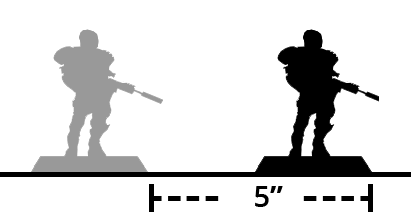
Dodge: A moving model can oppose attacks targeting it with a move roll. A winning move roll simply makes the attacks miss.
Example: An activated hungry hivemind alien charges an enemy android. The android (attack 5) reacts by shooting and the alien (move 7) dodges. The android rolls a 1 and the alien a 3. The aliens move roll wins cancelling the attack.
Climb: A model can climb upwards or over obstacles but each inch climbed counts as two inches moved. A model can spend multiple actions climbing during an activation but must end in a place where it can stand. A climbing model that is stunned falls down.
Jump: A moving model can jump between high ground. However, each inch jumped counts as two inches moved. The model also has to pass a move roll to land. If the roll fails, the model falls midjump. A model that falls takes one damage for each full 3" it fell down or for each elevation level if using 2D terrain.
A model that falls takes one damage for each full 3" it fell down or for each elevation level if using 2D terrain.
ATTACK1 action point
Choose a target in line of sight to attack with a weapon. Then make one to three attack rolls depending on the weapons firepower. The target makes a defence roll for each point of damage taken.
Note that weapons have unlimited range by default.
Example: The hungry hivemind alien (Attack 7, Firepower 3d10) slashes at an android in base contact, rolling a 1, 2 and 7. Three damage - the android has to make 3 defence rolls. It rolls 4, 5 and a 6 comparing them to its defence of 4. The 4 is successful but the 5 and 6 fails. The 5 is an odd number stunning the android but the 6 is even, killing it.
CAPTURE ENEMY2 action points
Remove a stunned enemy model in base contact from the battlefield.
STAND UP3 action points
A stunned model can use this action to recover from being stunned. Place the model standing on its base unless it was stunned again by a reaction.
SPECIAL ACTION 1 to 3 ap
Special actions are used for special things like using an ability, opening a door or interacting with an objective. Complex actions may require spending more than one action point.
.01.3
REACTIONS
Reactions are similar to actions except that they are done by enemy models during your turn. Reactions do not cost action points and you can't react to a reaction.
Each model can make a single reaction to an enemy action that starts in their line of sight. At the end of the action the reacting model is turned to face the active enemy model directly. Until the end of the turn the reacting model can't react to enemies in it's 180 degree rear arc.
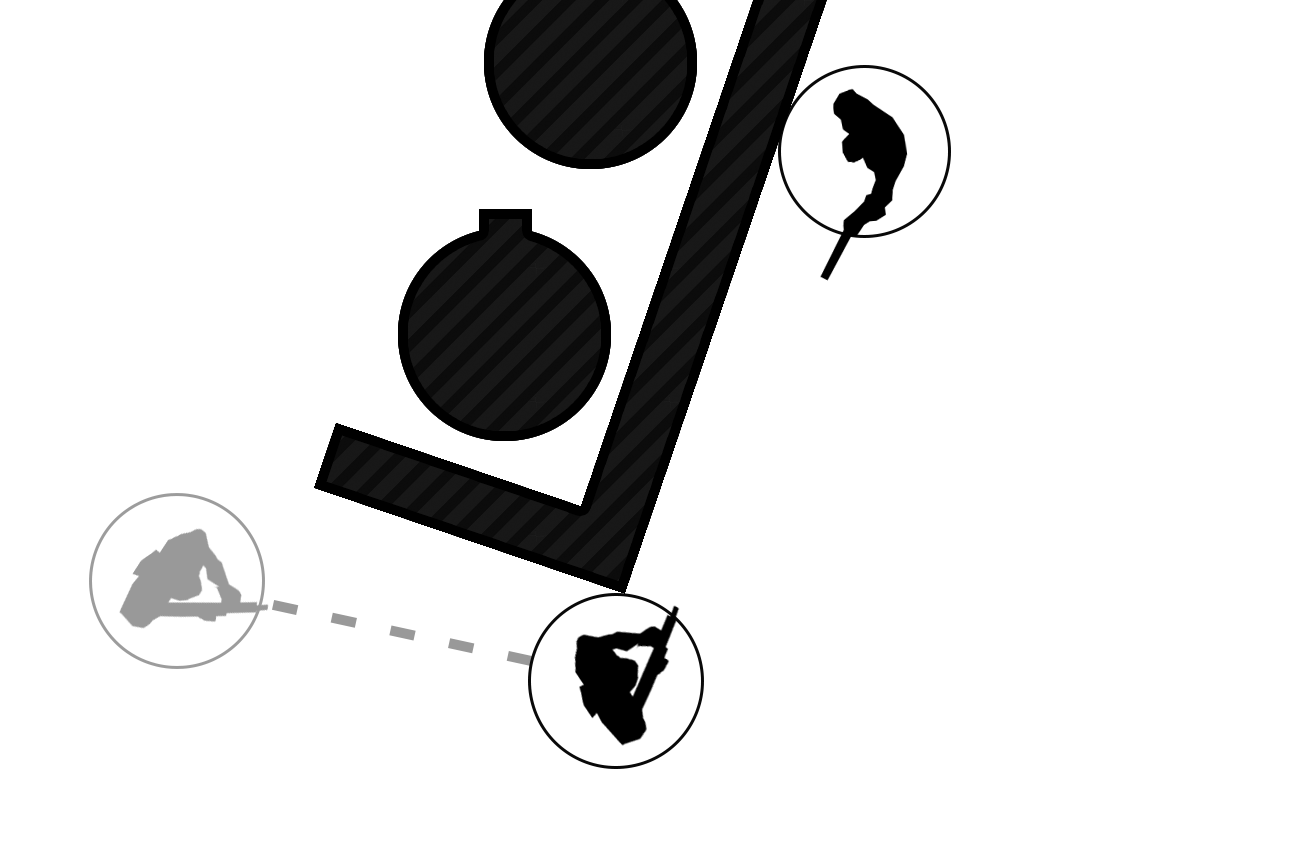
1) An activated model moves around a corner into an enemy's line of sight. The enemy can't react to this as the action didn't start in its line of sight.
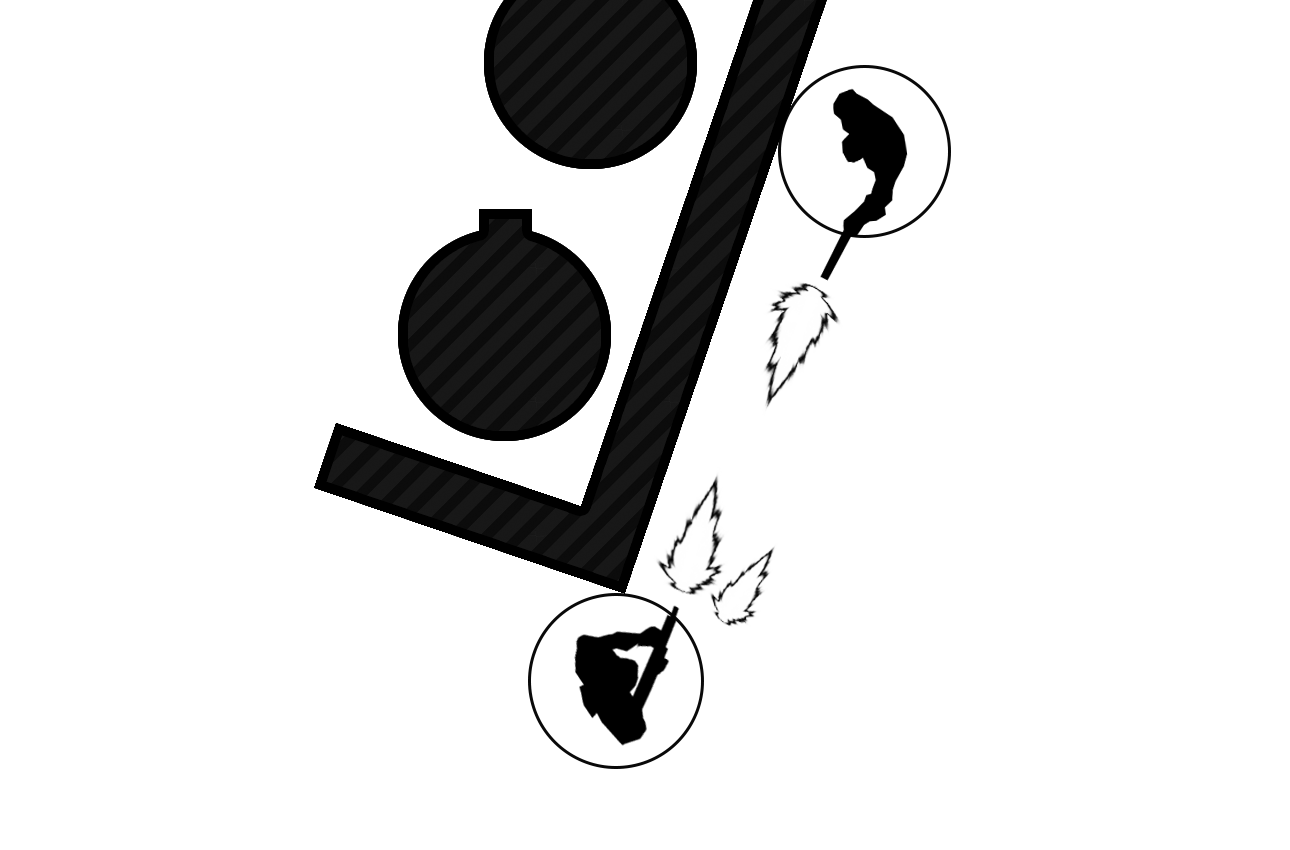
2) Next the active model makes an attack action. This time the enemy model is allowed to react and chooses to shoot back. Dice are rolled and the enemy is taken out of action.
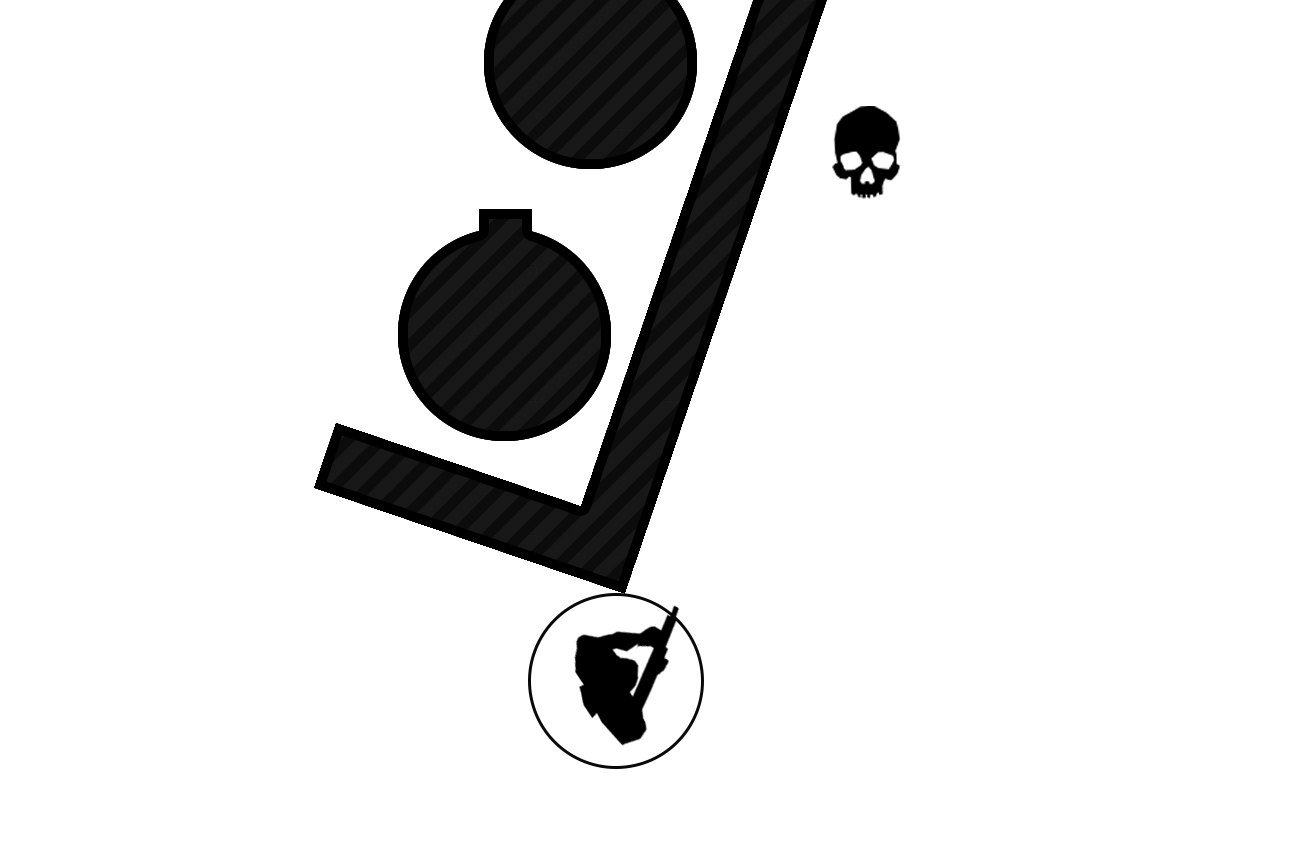
3) The active model ends its activation and makes 2 quality rolls. Only one fails so its player chooses another model to activate.
If the active model would have been taken out of action by the reactive shooting it would still have had to take its quality rolls.
FLANKING
A flanked model can't react. A model is flanked if it has line of sight to two enemy models and the distance between the enemy models is longer than either distance to the flanked model.
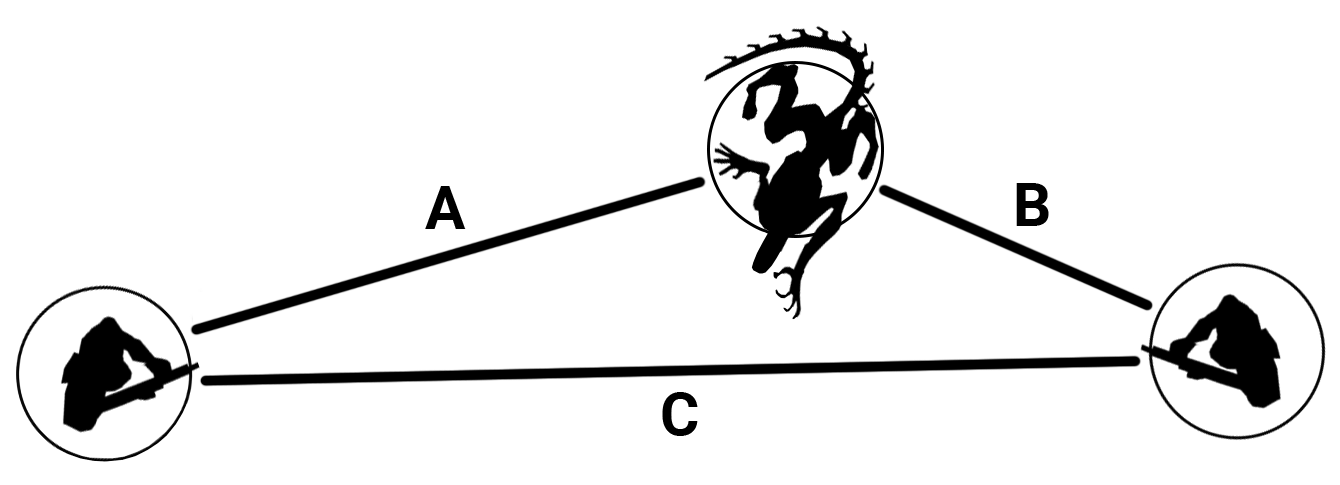
The hungry hivemind alien is flanked because C is longer than A or B.
MOVE REACTION
Move the model up to its move in inches. The model may dodge, opposing attack rolls targeting it with a move roll. A move reaction can not take a model out of base contact with an active enemy model.
ATTACK REACTION
Resolved as an attack action but only make a single attack roll with damage one regardless of the weapon used. However, weapon traits do work when reacting. Active and reactive attacks from models targeting each other are resolved as an opposed roll.
Example: An activated mercenary (Attack 6, firepower 2d10) aims her assault rifle at a spiderbot (Attack 6, firepower 3d10) which returns fire.
Because the spiderbot is reacting it only gets to roll one attack dice instead of 3. The mercenary makes 2 attack rolls: 1 and 5 while the spiderbot rolls a 3. The spider's 3 cancels the mercenary's 1 but is in turn canceled by the 5. The spiderbot (defence 3) takes one damage and has to make a defence roll. It rolls a 10 and is destroyed.
If the spiderbot would have had any allies that also reacted by attacking the mercenary, those attacks would have been unopposed as the marine targeted the spiderbot.
STEAL INITIATIVE REACTION
The steal initiative reaction allows you to oppose the active model's quality roll at the end of its activation with a single quality roll of your own. You get to make the opposing quality roll even if your model is killed or stunned by the active model.

The mercenary from the previous example continues her activation moving along the battlefields edge twice in an attempt to flank the enemy warband. The robots have posted an unarmed hoverbot which discovers the mercenary and makes a steal initiative reaction!
The mercenary (quality 6) decides to end her activation and makes three quality rolls getting 1, 3 and 3. Due to the steal initiative reaction the observer bot (quality 5) gets to make an opposed quality roll. It rolls a 5 canceling all of the mercenary's rolls! It becomes the robots' turn as they get alerted!
.01.4
TERRAIN
Terrain is treated as areas with rules attached to them or as special objects. Players should agree on what each terrain piece represents while deploying them. If a models base is touching a terrain piece it’s affected by it.
BASIC TERRAIN
Hiding: Can be seen into but not through. Eg. Smoke or dense vegetation but also hills.
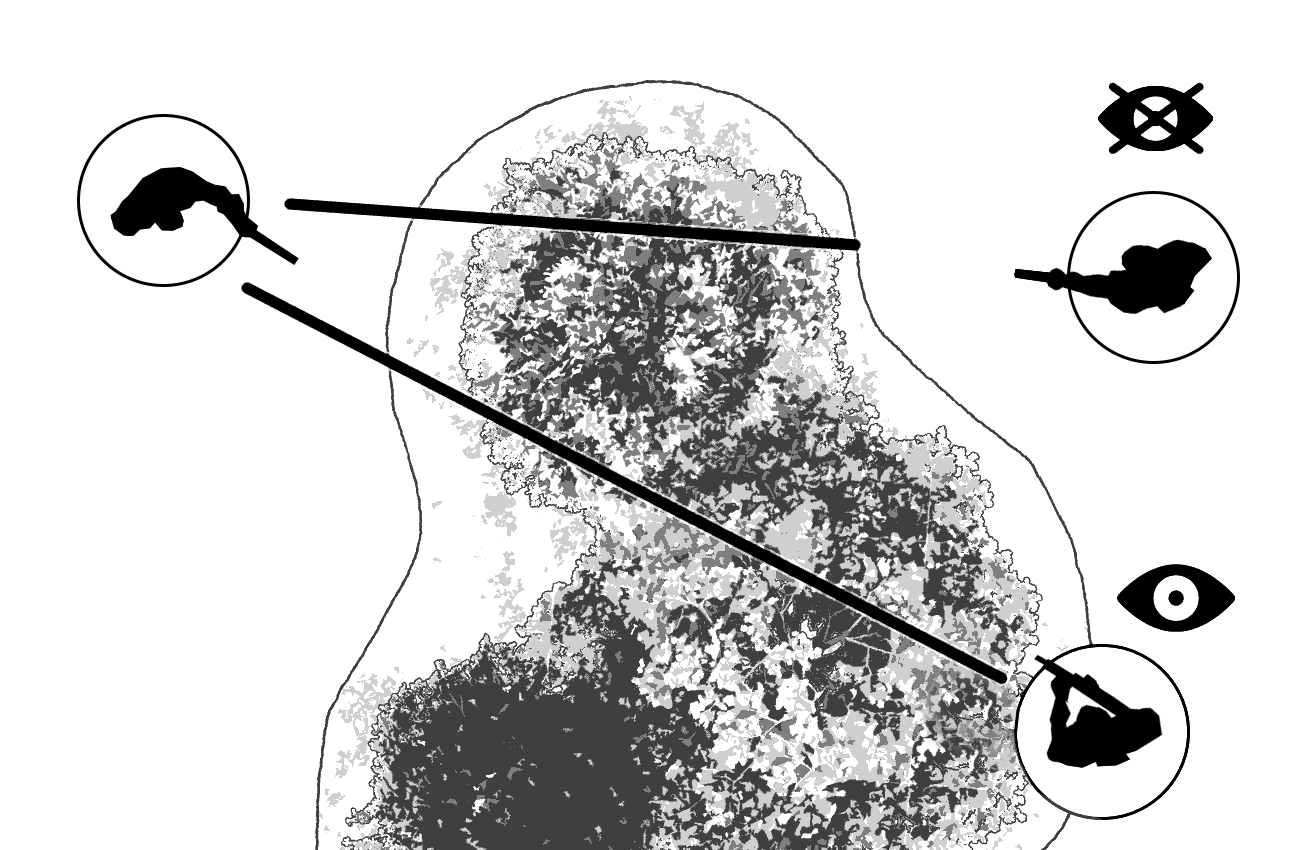
You should have a lot of hiding terrain on the battlefield.
Cover: Allows a model to re-roll single defence roll when taking damage from a ranged attack. To gain cover a models base has to be obscured by and be in base contact with the terrain.
Hiding and high ground terrain often give cover as well.
Difficult: An active model has to end its activation after moving through any difficult terrain.
A model can't do anything after moving through even a little difficult terrain.
High ground: Allows a model to re-roll a single attack dice when attacking models in lower terrain. Define high ground levels when placing terrain if using 2D terrain instead of 3D terrain.
A model that falls from high ground takes one damage for each full 3" it fell down or for each elevation level it fell down if using 2D terrain.
Impassable: Can’t be moved through. Define what impassable terrain can be climbed when placing terrain.
Walls are impassable and hiding terrain.
SPECIAL TERRAIN
Destructible: Can be targeted by attacks. Has a defence 7 and 1 hit point unless defined as higher or lower. Remove the piece of terrain once it is taken out of action by damage. It ignores stunned results. Cracked walls, doors and hatches are examples of destructible terrain.
Door: A door can be opened or closed as a special action in base contact with the door. A closed door is impassable and hiding.
Explosive: Can be targeted by attacks. Explodes and is removed if it takes any damage. The explosion causes one damage to every model in the terrain piece or within 5” of it. For example an exploding barrel.
Hazardous: A model takes one damage if it moves through, ends an activation in or ends a reaction in hazardous terrain.
Push enemies into lava for great effect.
Ladder: A model can climb up a ladder at its full speed instead of half.
Rift: A model pushed into a rift is killed as it falls to its doom. A moving model can jump over a rift by passing a move roll. If the roll fails the model falls to its death.
Portal: Always placed in pairs. Model that ends a move in base contact with the portal can warp into base contact with the paired portal. Portals are surprisingly common on fringe exoplanets.
.01.5
MISSIONS
Ok, so you have some miniatures, an opponent, dice etc. – what now?
First you and your opponent should agree on a mission budget. This is how many galactic credits (gc) you get to spend on your warband. You can find gc costs in chapters 02 Species, 03 The Armory and 04 Abilities. It makes sense to choose the mission budget before playing so both of you can prepare your warbands in advance. Here are some suggestions for mission budgets:
- 500 gc for a quick game with about 4 or 5 models per side.
- 1000 gc for a battle.
- 2000 gc or more for pandemonium.
THE BATTLEFIELD
The battlefield should preferably be at least 30" × 30". A battlefield of 36" × 48" is perfect. The battlefield edges are impassable terrain.
Once both players have designed their warbands you should deploy terrain. It’s also almost mandatory to put on background music from some action movie or game at this point. Due to reactions, it's very important to have lots of hiding terrain to block line of sight. At least a third of the battlefield should be covered by terrain and there should be few or no open lanes across the battlefield wider than 3". The players take turns to place terrain pieces or agree on the general layout of the battlefield. Alternatively you can have an impartial observer prepare the battlefield.
WARBAND DEPLOYMENT
Once the terrain has been placed players should present their warbands. Bragging and boasting is encouraged but try to keep it civil. Both players roll a d10. Re-roll if the rolls are equal. The player with the higher roll choose to deploy first or second. The player deploying first chooses one of the long table edges and deploys his or her warband within 3” from the edge. Afterwards the deploys his or her warband along the opposing table edge. The player deploying first has the turn at the start of the mission.
ENDING THE MISSION
Retreat: If all the remaining models in the enemy warband are stunned they retreat and you win. You may retreat voluntarily if over half of your models are stunned or dead.
Wipeout: If all enemy models are killed or are outside the battlefield for some other reason your warband wins.
Turn limit & area control: The game ends after both players have played 6 turns. If this happens, divide the battlefield into 4 areas by drawing an X between opposite battlefield corners. You controll areas which only contain models from your warband. Ignore stunned models. Roll a dice for models on area edges to randomize their area. You win if you have more areas under your control than your opponent. If these are equal the warband with the lower galactic credits total wins. If these are also equal the game is a draw.
.02
SPECIES
This chapter describes how to create characters. There is also a list of example characters to use if you don't want to create your own. Mix and match adventurers freely, there is no rule saying a warbands members have be from the same species. There are two guidelines however.
Firstly, have a theme to your warband. Maybe they are greedy mercenaries working for an evil corporation, a squad of colonial marine veterans or a ragtag bunch of outdated renegade robots? You can certainly develop the theme over time too.
Secondly, each model should be named and stand out in some way instead of being carbon copies of each other.
CREATING AN ADVENTURER
Begin by designing a statline for your model and proceed by arming it to the teeth. Add the cost of the statline, weapons and abilities to get the points cost of the model. Use the following formula to calculate the models statlines cost in Galactic Credits:
(M×Q + A×Q + A×D) × (1 + HP) / 2
Move, Quality and Attack have to be 3-9 while Defence and Hit Points have to be 1-7. Every model needs to have these basic stats and everything else is optional.
A warband can only have one model with attack
8 or 9. In a campaign loot may bring you above these limits.
Here is how you can calculate it in your head: Every point of Attack costs as much as Quality + Defence and every point of Move costs as much as Quality. Then multiply the cost of Attack and Move by: 1 if 1HP, 1.5 if 2HP or 2 if 3HP etc.
...Or you can use this calculator to get the basic cost for the model.
= 84gc
Move, Quality and Attack have to be 3-9 while Defence and Hit Points have to be 1-7. Every model needs to have these basic stats and everything else is optional.
A terran may have these stats:
Move 5
Attack 6
Defence 3
Quality 6
Hit Points 1
Hiring her to your warband costs:
(5×6 + 6×6 + 6×3) × (1 + 1) / 2 = 84 gc
She will be equipped with a plasmarifle (40gc) and an energy shield (24gc).
The terran and her wargear would thus cost 84 gc + 40 gc + 24 gc = 148 gc in total.
TERRANS
Basic humans - you should have heard of these.
Terrans often use standard and armor-piercing ballistic weapons or explosives. Terrans often have teamwork promoting abilities such as leader, medic or ammo support.
Terran colonist35 gc
| M | A | D | Q | HP |
|---|---|---|---|---|
| 5 | 5 | 1 | 3 | 1 |
Combat armor (+1D)5 gc
Power armor (+2D)10 gc
Terran mercenary81 gc
| M | A | D | Q | HP |
|---|---|---|---|---|
| 5 | 7 | 3 | 5 | 1 |
Combat armor (+1D)6 gc
Power armor (+2D)12 gc
Android109 gc
| M | A | D | Q | HP |
|---|---|---|---|---|
| 5 | 6 | 3 | 6 | 1 |
Abilities: AI
Combat armor (+1D)6 gc
Power armor (+2D)12 gc
Terran soldier of fortune165 gc
| M | A | D | Q | HP |
|---|---|---|---|---|
| 5 | 8 | 4 | 6 | 2 |
Combat armor (+1D)12 gc
Power armor (+2D)24 gc
Terran hero224 gc
| M | A | D | Q | HP |
|---|---|---|---|---|
| 5 | 7 | 4 | 7 | 3 |
Combat armor (+1D)14 gc
Power armor (+2D)28 gc
SUPERTERRANS
Genemodified terran warriors. Cloned, brainwashed and at your service.
Superterrans are often equiped with armor-piercing or plasma ballistic weapons or melee weapons. Superterrans often have abilities like inspire, energy shield or smoke screen.
Superterran knight179 gc
| M | A | D | Q | HP |
|---|---|---|---|---|
| 6 | 7 | 4 | 7 | 2 |
Combat armor (+1D)10 gc
Power armor (+2D)21 gc
Heavy power armor (+2D, Big)51 gc
Superterran ranger129 gc
| M | A | D | Q | HP |
|---|---|---|---|---|
| 6 | 7 | 4 | 7 | 1 |
Abilities: Pathfinder
Combat armor (+1D)7 gc
Superterran veteran207 gc
| M | A | D | Q | HP |
|---|---|---|---|---|
| 6 | 8 | 5 | 7 | 3 |
Combat armor (+1D)12 gc
Power armor (+2D)24 gc
Ranger armor (+1D, Pathfinder)22 gc
Heavy power armor (+2D, Big)54 gc
STARFARERS
Mysterious starfarers with pointy ears. They have slender yet fragile bodies from living in low gravity.
Starfarers prefer laser weapons as well as energy melee weapons and psychic attacks. Some common starfarer abilities include flying, invisibility and reflect.
Starfarer114 gc
| M | A | D | Q | HP |
|---|---|---|---|---|
| 6 | 8 | 2 | 7 | 1 |
Spacesuit (+1D)8 gc
Battlesuit (+2D)16 gc
Automaton96 gc
| M | A | D | Q | HP |
|---|---|---|---|---|
| 6 | 5 | 6 | 6 | 1 |
Abilities: Robot
Heavy frame (+1HP, Big)78 gc
Juggernaut frame (+2HP, Big)126 gc
Starfarer captain204 gc
| M | A | D | Q | HP |
|---|---|---|---|---|
| 6 | 8 | 3 | 8 | 2 |
Abilities: Leader
Spacesuit (+1D)12 gc
Battlesuit (+2D)24 gc
LOCUST
Hungry spacebugs. Can't be communicated with and eat everything and everyone. Maybe they are just misunderstood?
Locust often kill their prey with bioengineered poison and plasma ballistic weapons or melee weapons. They often possess abilities such as Infiltrator, shock entry and stealth.
Locust hatchling33 gc
| M | A | D | Q | HP |
|---|---|---|---|---|
| 7 | 3 | 1 | 3 | 1 |
Abilities: Hivemind, Facehugger
Locust swarmer49 gc
| M | A | D | Q | HP |
|---|---|---|---|---|
| 7 | 7 | 1 | 3 | 1 |
Abilities: Hivemind
Exoskeleton (+1D)7 gc
Extended Carapace (+2D)14 gc
Locust guardian116 gc
| M | A | D | Q | HP |
|---|---|---|---|---|
| 7 | 7 | 1 | 5 | 2 |
Abilities: Hivemind
Exoskeleton (+1D)10 gc
Extended Carapace (+2D)21 gc
Locust prime214 gc
| M | A | D | Q | HP |
|---|---|---|---|---|
| 7 | 8 | 5 | 6 | 3 |
Abilities: Hivemind
Exoskeleton (+1D)16 gc
Extended Carapace (+2D)32 gc
Huge (+1 HP, Big)84 gc
Massive (+2 Hp, Big)137 gc
MUTANTS
Three favourite activities: fighting, fighting and fighting.
Mutants use a wide variety of looted or improvised weapons. Some mutants have gained abilities like dualwielder, regeneration or rush.
Mutant barbarian56 gc
| M | A | D | Q | HP |
|---|---|---|---|---|
| 5 | 6 | 2 | 4 | 1 |
Armor (+1D)6 gc
Heavy armor (+2D)12 gc
Mutant cyborg102 gc
| M | A | D | Q | HP |
|---|---|---|---|---|
| 5 | 6 | 4 | 4 | 2 |
Abilities: Robot
Armor (+1D)9 gc
Heavy armor (+2D)18 gc
Mega armor (+2D, Big)48 gc
Mutant boss166 gc
| M | A | D | Q | HP |
|---|---|---|---|---|
| 6 | 7 | 5 | 4 | 3 |
Armor (+1D)14 gc
Heavy armor (+2D)28 gc
Mega armor (+2D, Big)58 gc
RENEGADES
Madmen led by scary, genocidal superterrans bent on enslaving humanity to their dark will. To get the point across they decorate their armor with spikes, skulls and skulls on spikes.
Reports often mention renegades being armed with standard and plasma ballistic weapons or melee weapons. Some common renegade abilities include mind control, fire screen and portal.
Renegade superterran120 gc
| M | A | D | Q | HP |
|---|---|---|---|---|
| 6 | 8 | 4 | 5 | 2 |
Combat armor (+1D)12 gc
Power armor (+2D)24 gc
Heavy power armor (+2D, Big)54 gc
Cultist62 gc
| M | A | D | Q | HP |
|---|---|---|---|---|
| 5 | 6 | 3 | 4 | 1 |
Armor (+1D)6 gc
Heavy armor (+2D)12 gc
Zombie25 gc
| M | A | D | Q | HP |
|---|---|---|---|---|
| 3 | 3 | 1 | 3 | 1 |
Abilities: Facehugger
Exterminator97 gc
| M | A | D | Q | HP |
|---|---|---|---|---|
| 4 | 7 | 6 | 5 | 1 |
Abilities: Robot
Heavy frame (+1HP, Big)79 gc
Juggernaut frame (+2HP, Big)127 gc
Superterran Warlord180 gc
| M | A | D | Q | HP |
|---|---|---|---|---|
| 6 | 9 | 5 | 5 | 2 |
Abilities: Leader
Combat armor (+1D)14 gc
Power armor (+2D)27 gc
Heavy power armor (+2D, Big)57 gc
.03
THE ARMORY
On the following pages you’ll find a smorgasbord of kaboomboom which allows you to turn your opponents warband into a dead warband.
WEAPON TRAITS
Armor-piercing: Target defence counts as 4 regardless if it's higher or lower.
3” Blast: Any model within 3" of target takes damage. Measure the range from the models base or exploding terrains edge. Cover direction is checked from the blast center.
Energy: Armor-piercing when active.
Heavy: Attacking after moving costs an additional action point.
Ignores cover: Cover re-rolls can't be used against this weapon.
Light: A model may attack with this weapon at the start of a move action or reaction. This replaces dodging. The attack and move counts as a single action so enemies can only react to it once.
Melee: The weapon may only be used in base contact. The users attack counts as 9 unless opposed by an attack with another melee weapon.
Nonlethal: The weapon never causes damage to friendly models. An enemy model that would be killed by a nonlethal attack is stunned instead.
Poison: A model that looses HP when taking damage from a poison weapon is also stunned.
Psychic: You may spend one or two additional action points to attack with a psychic attack. The attack gains one firepower for each extra action point spent.
3" Push: Target model is moved 3" directly away from the attacker if any damage is caused by this weapon. The pushed model stops and takes one damage if it comes into contact with impassable terrain or another model. The model hit by the pushed model also takes one damage. Furthermore, the pushed model takes one damage if it's pushed through difficult terrain.
Reload: The weapon can only be used once per activation.

WEAPON UPGRADES
You can add one upgrade to a weapon. Most of them do not cost galactic credits, but add both positive and negative traits to the weapon.
BALLISTIC WEAPONS
| Cost | Type | FP | Dmg | Traits |
|---|---|---|---|---|
| 10 gc | Pistol | 1d10 | 1 | Light |
| 15 gc | Shotgun | 1d10 | 3 | 3" Push, 8" Max range |
| 20 gc | Autorifle | 2d10 | 1 | |
| 25 gc | Sniper rifle | 1d10 | 3 | Heavy |
| 30 gc | Heavy autorifle | 3d10 | 1 | Heavy |
| Ballistic weapon upgrades: | ||||
| free | AP | Armor-piercing | ||
| free | Laser | Energy | ||
| free | Flamer | 8" Max Range, Ignores cover, remove 3" Push | ||
| free | Poison | Poison, Reload | ||
| free | Gravity | +3" Push, Reload | ||
| free | Stun | +1 | Nonlethal, Reload |
EXPLOSIVE WEAPONS
| Cost | Type | FP | Dmg | Traits |
|---|---|---|---|---|
| 10 gc | Grenades | 1d10 | 1 | 3" Blast, Ignores cover, Max range 8" |
| 20 gc | Grenade launcher | 1d10 | 1 | 3" Blast |
| 30 gc | Rocket launcher or cannon | 1d10 | 2 | 3" Blast, Heavy |
| Explosive weapon upgrades: | ||||
| free | AP | Armor-piercing | ||
| free | Fusion | Energy | ||
| free | Poison | Poison, Reload | ||
| free | Gravity | 3" Push away from target, Reload | ||
| free | Stun | +1 | Nonlethal, Reload | |
| 2x | Antimatter | +1 | Reload |
MELEE ATTACKS
| Cost | Type | FP | Dmg | Traits |
|---|---|---|---|---|
| free | Unarmed | 1d10 | 1 | Melee |
| 5 gc | Martial arts or short blade | 2d10 | 1 | Melee |
| 10 gc | Blade or claws | 3d10 | 1 | Melee |
| 10 gc | Whip or tentacles | 1d10 | 2 | Melee, Light |
| 10 gc | Club or bite | 2d10 | 2 | Melee, Heavy |
| 10 gc | Spear or tailspike | 1d10 | 3 | Melee |
| 20 gc | Monstrous strength | 2d10 | 3 | Melee, Big models only |
| Melee attack upgrades: | ||||
| free | AP | Armor-piercing | ||
| free | Bright | Energy | ||
| free | Gravity | 3" Push | ||
| free | Charged | 3" Blast, Reload, ignore damage to self | ||
| free | Poison | Poison, Reload | ||
| free | Stun | +1 | Nonlethal, Reload |
PSYCHIC ATTACKS
| Cost | Type | FP | Dmg | Traits |
|---|---|---|---|---|
| 20 gc | Delta level PSI | 1d10 | 1 | Psychic, Nonlethal |
| 35 gc | Gamma level PSI | 1d10 | 1 | Psychic |
| 70 gc | Beta level PSI | 1d10 | 2 | Psychic |
| 105 gc | Alpha level PSI | 1d10 | 3 | Psychic |
| Psychic attack upgrades: | ||||
| +10 gc | Telekinesis | 3" Push | ||
| +10 gc | Pyrokinesis | Ignores Cover | ||
| +10 gc | Electrokinesis | Energy | ||
| +25 gc | Implosion | Nonlethal, 3" Blast, 3" Push toward target |
.04
ABILITIES
AI15 gc
An AI model may spend up to 4 action points during its activation if no other models from the warband have been activated this turn. If other models have been activated this turn, the AI model can only spend up to 2 action points.
Ammo Support20 gc
An active friendly model in base contact may ignore the reload weapon trait once per activation.
Berserkerfree
A berserker may only spend up to 2 action points during its activation. However, if an enemy is stunned or killed during its activation, it may spend up to 4 action points.

Bigfree
If the model would get stunned it looses one HP instead. Move actions and special move actions after the first one cost an additional action point.
Climber10 gc
A climber can climb without movement penalty.
Bodyguard15 gc
An enemy model with line of sight to a bodyguard can't target models in base contact with the bodyguard. Melee attacks ignore this restriction.
Dualwielder10 gc
An active dualwielder that uses a light or melee weapon in an attack action may make an offhand attack with another light or melee weapon. This is a separate action that costs zero action points.
Energy beingfree
A stunned energy being may make a special stand up action for three action points. The energy being recovers from being stunned and may be placed in base contact with any friendly model. However, a stunned energy being is automatically taken out of action by an enemy model in base contact.
Energy shield20 gc
An energy shield wielder that fails a defence roll and would loose HP may choose to get stunned instead. However, a stunned model's energy shield is recharging and offers no protection.
Facehuggerfree
A facehugger can facehug a stunned enemy model in base contact for 2 action points as a special action. A facehugger may only attack once per activation. You may either replace the facehugged enemy with a zombie under your control or kill your facehugger and take control of the enemy model. A controlled enemy switches sides to your warband. You can find the zombie's stats under Renegades in chapter 02.
Fire screen15 gc
The model can lit an area aflame as a special action costing 1 action point. Deploy a round 5" diameter hazardous terrain piece within 8". Remove it at the start of your next turn.
Flying25 gc
The model may fly as a special move action. This costs two action points and allows the model to move up to three times its move in a straight line. The model falls directly downwards at the end of the flying move. A flying model ignores falling damage.
Hacker15 gc
This model can hack an enemy model for three action points. Target an enemy model in line of sight to any of your models and end the hackers activation. If you pass the turn to the hacked model, it can only spend a single action point during its activation.
Heal15 gc
This model can heal itself or a model in base contact as a special action costing 3 action points. Restore one hit point lost earlier in the battle to the healed model.
Hivemindfree
Select one hivemind model to be the hivemind master when designing your warband. Hivemind models other than the master may spend up to 4 action points per activation if the master is on the battlefield. However, if the master is killed or stunned, hivemind models can only spend up to 2 action points per activation.
Infiltratorfree
An infiltrator is deployed on your first game turn. Place it anywhere on the battlefield over 3" from enemy models and out of enemy line of sight. The infiltrator is deployed stunned.
Inspire20 gc
The model can inspire a model in line of sight as a special action costing 2 action points. The inspired model may spend up to 4 action points if it's the next model to be activated.
Invisibility40 gc
Can only be targeted from within 8” unless activated.
Leader10 gc
A model with line of sight to a friendly leader may re-roll a single quality roll at the end of its activation. A warband can only have one leader.
Medic25 gc
The stand up action only costs two action points for stunned friendly models within 5".
Mind control25 gc
The model can gain control of an enemy in line of sight as a special action costing 3 action points. The enemy model is part of your warband until the end of your turn.
Pathfinder10 gc
This model does not have to end its activation after moving through difficult terrain.
Portal30 gc
The model can open portals in the fabric of spacetime as a special action costing 3 action points. Deploy a 3” diameter round portal terrain piece in base contact with the model model. Deploy another paired identical portal anywhere on the battlefield.
The ability can also be used to close a portal in base contact with the model. This is also a special action and costs 2 action points. Closing a portal closes its paired portal as well.
Reflect30 gc
The model can reflect attacks back to their source by opening microportals as a special reaction. Make an attack roll opposing the active models attack. Every attack roll you cancel is reflected and damages the active model instead. Flailing a trademarked energy sword is optional.
Regenerate25 gc
A regenerating model may regain a HP lost earlier in the battle as a special action costing 2 action points.
Reptilefree
A reptile may move twice as far with the move reaction. However, a reptile may only make one attack reaction during an enemy activation.
Robotfree
A robot can spend up to 4 action points per activation. It must end it's activation after completing an action that is not the same as the first one.

Rushfree
A rusher may spend up to 4 action points during its activation if no enemies are in line of sight at the start of the activation. If an enemy is in line of sight at the start of the action, the rusher can only spend up to 2 action points. Rush B.
Shock entry25 gc
This model can be left off the battlefield during deployment. From outside the battlefield the model can be activated to make a shock entry as a special move costing 3 action points. A model doing a shock entry can be placed anywhere on the battlefield over 3” from enemy models.
Silicon beingfree
A silicon being ignores hazardous terrain but may only move up to 1" with a move reaction.
Smoke screen15 gc
The model can create a smoke screen as a special action costing 1 action point. Deploy a round 5" diameter covering terrain piece within 8". Remove it at the start of your next turn.
Stealth15 gc
A stealthy model can use a special sneak move action if it started its activation outside enemy line of sight. Sneaking is identical to move, except enemies can't react to the first sneak move starting in their line of sight. You can't use a light weapon as part of a sneak move.
Teleport25 gc
The model may teleport to any point in line of sight as a special move. This costs 3 action points.
Telepathicfree
A telepathic model can spend up to 4 action points during its activation if the activation starts with line of sight to at least 2 other friendly telepathic models. If not, the model can only spend up to two action points during its activation.

